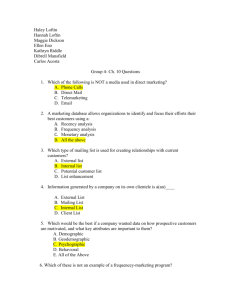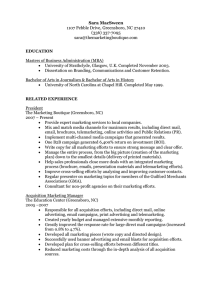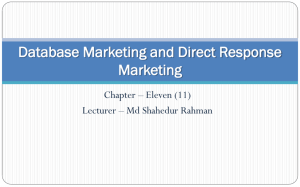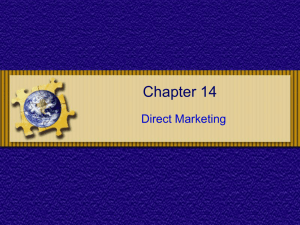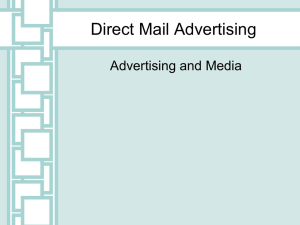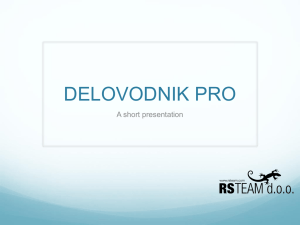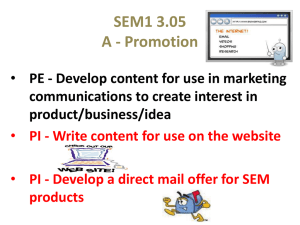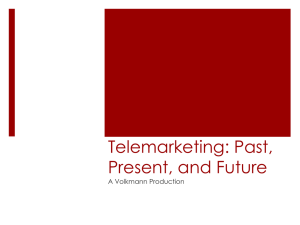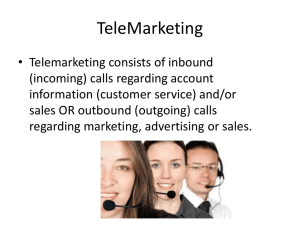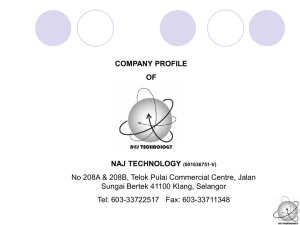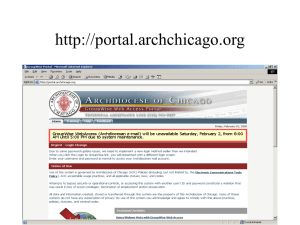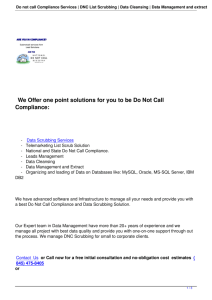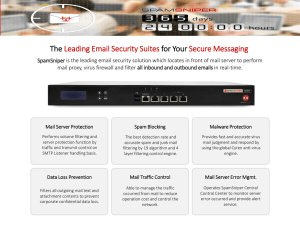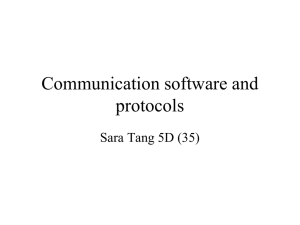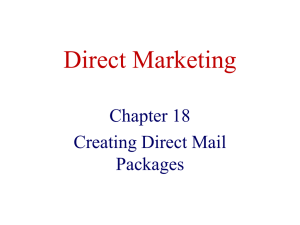Chapter 17 Integrating Direct Marketing and Personal Selling
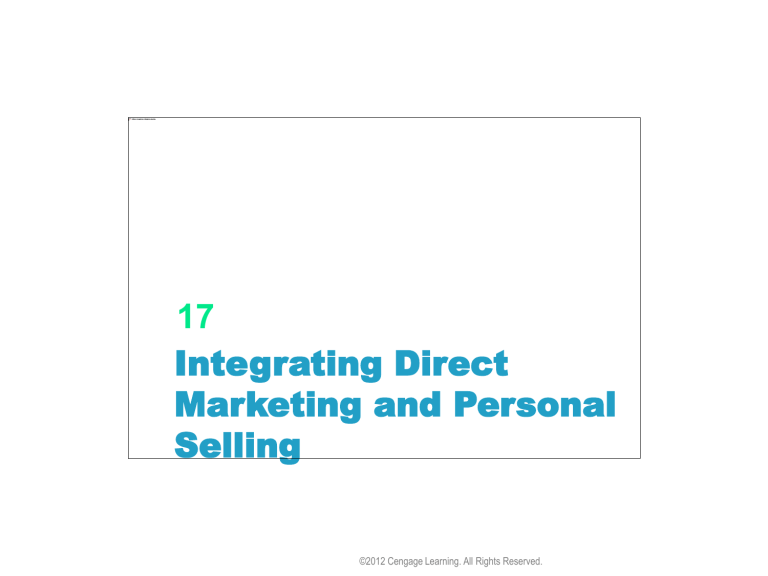
17
Integrating Direct
Marketing and Personal
Selling
©2012 Cengage Learning. All Rights Reserved.
Introductory Scenario:
Don’t Mess With Les
Who was Les Wunderman?
• He created the Columbia House record club and
“invented” the modern era of direct marketing.
• The genius of his idea was creating a dialogue
(monthly response) with consumers which led to building a relationship with the brand.
• This “relationship” created through dialogue resulted in multiple purchases over time.
The Evolution of Direct Marketing
An interactive system of marketing which uses one or more advertising media to effect a measurable response and/or transaction at any location.
•
The scope of direct marketing: o An interactive dialogue with consumers o o o
Pursues an immediate, measureable response (e.g. sale or inquiry)
Identify prospects for future contacts
Transactions can take place anywhere o Mail, telephone, Internet o Availability in the physical and virtual world
Direct Marketing: A Look Back
• L.L. Bean was founded in 1912 on $400.00
• Fundamental strategy: o Commitment to quality o o
Descriptive copy that was informative, factual, and low-key
Satisfaction guarantee
• L.L. Bean built a good mailing list
• By 1990 L.L. Bean’s sales were $600 million; by 2009, over $1.4 billion
Direct Marketing: Milestones
1450 Invention of movable type
1667 First gardening catalog
1744 Franklin formulates mail-order concept of
“satisfaction guaranteed”
1872 Montgomery Ward catalog
1886 Sears starts mail-order business
1917 Direct Marketing Advertising Association founded
Direct Marketing: Milestones
1928 Third-class bulk mail introduced
1950 First credit card
1951 Lillian Vernon places first ad
1953 Publishers Clearing House founded
1967 AT&T introduces toll-free 800 service
1992 Over 100 million in U.S. shop at home
Direct Marketing Today
• Rooted in, but much more than just mail-order.
• Many different activities using multiple media
• A complex, diverse tool used by organizations throughout the world.
• Three Principle Purposes: o Close a sale with a customer o o
ID prospects and develop customer database
Engage customers, seek their advice and generate brand loyalty —remember consumer generated content—how are new technologies being used to do this?
What’s Driving the Growth of
Direct Marketing?
• CONVENIENCE for today’s dual income and single parent households.
• Still liberal attitudes toward using credit —despite the recent recession.
• Greater access to toll-free calling.
• Computer technology/new media facilitate online transactions and database management.
• More precise segmentation.
• Opportunity for relationship building.
• Cost per inquiry (CPI) and cost per order (CPO) advantages of direct marketing.
Marketers like the
Adirondack Country
Store, use catalogs, toll- free numbers, and the Web to take advantage of direct marketing opportunities.
Database Marketing
• Knowing who the best customers are as well as what and how often they buy.
• Mailing lists: o Internal lists (existing customers) o External lists
Databases allow firms to reach their best customers with direct mailings.
List Enhancement
• Internal lists can be augmented with externally provided lists
• Incorporating information from external databases o Demographic data o Geo-demographic data o Psychographic data o Behavioral data
The Marketing Database
• Includes data collected directly from individual customers
• Goal: Develop cyber intimacy
• Database marketing creates efficiencies
– Targeted versions of catalogs: seasonal, age specific
Marketing Database Applications
• Includes data collected directly from individual customers o RFM Analysis of customers: recency, frequency, and monetary o Past behaviors can be used to predict future behavior
• Reinforcing and recognizing best customers o Frequency-marketing programs o Cross-selling
• Stronger position to cultivate new customers through more astute external list purchases
The Privacy Concern
• Privacy concerns result in: o Do not call registry o Spam blockers o Opt-out options
• Firms can overcome privacy concerns o Nurture the relationship with current customers with honest, effective service
The Internet has heighted consumer privacy concerns with respect to direct marketing
Media Applications in Direct Marketing
• Direct response advertising on TV
• Direct Mail
• Telemarketing
• Email/Mobile marketing
• Other media o Magazines o o
Newspapers
Infomercials
Direct Mail
Advantages
• Selective, flexible, little waste, lends itself to testing, uses many formats
Disadvantages
• Direct mail is expensive o May cost 15 to 20 times more to reach a person with a direct mail piece than with a
TV commercial
• Mail lists can be plagued with bad addresses
• Mail delivery dates can be unpredictable
Telemarketing
• Telemarketing can be a potent tool. As with direct mail: o o o o
Contacts can be selectively targeted.
The impact of programs is easy to track.
Experimentation with different scripts and delivery formats is simple and practical.
Telemarketing involves live constructive dialogue.
• Telemarketing shares many of direct mail’s limitations: o o o o o
Very expensive on a cost-per-contact basis.
Names and addresses go bad as people move, and wide spread use of cell phones has made directories nearly obsolete.
Telemarketing does not share direct mail’s flexibility in delivery options. When you reach people in their home or workplace, you have a limited span of time to convey information and request some response.
Telemarketing is becoming a highly maligned practice in consumers.
The FTC’s “Do Not Call” list has millions of subscribers
• Bulk email is known as “spam”
• Fraudulent email know as “phishing”
• However email is an increasingly popular tool for marketers
• Advantages o Cheap o Good response rates —better than direct mail
• Netiquette suggests getting consumer permission to send product information
(i.e. obtaining opt-in permission)
• Avoid bulk emailings
Direct Response Advertising in Other
Media
• Magazines use bind-in insert cards
• Toll-free 800 numbers are vital to direct marketers using ads in newspapers and magazines
• Infomercial o o o
Long television advertisement
Range in length from 3 to 60 minutes
Keys to success
Testimonials, frequent call to actions, ensure same-day response
New research shows that direct response ads are the least likely to be zapped by
DVR users
Magazine ads are ideal for
Direct
Response
Advertising.
Closing the Sale with
Direct Marketing and/or Personal
Selling
• Functional specialists across several media need to work together.
• Marketing databases can lead to interdepartmental rivalries.
• Growth of direct marketing often means cuts in other promotional budgets.
• One solution: the MARCOM manager
The Critical Role of Personal Selling
• The face-to-face communication and persuasion process
• Most effective with products or services that are: o o o o o
Higher priced
Complicated to use
Tailored/customized to users’ needs
Offer a trade-in option
Judged at the point-of-purchase
Types of Personal Selling
Order taking:
Accepting orders for merchandise or scheduling services; deal with existing customers who are lucrative to a business due the low cost of generating additional revenues from them. Order taking is the least sophisticated of selling efforts.
Creative selling:
Selling where customers rely heavily on the salesperson for technical information, advice, and service. It is the most sophisticated and complex selling effort.
System selling:
Entails selling a set of interrelated components that fulfill all or a majority of a customer’s needs in a particular area. System selling is often executed by a “team” of sales people.
The missionary salesperson:
Calls on accounts with the purpose of monitoring the satisfaction of buyers and updating buyers’ needs. They may provide product information after a purchase.
Customer Relationship
Management (CRM)
• Salespeople play a critical role in cultivating long-term relationships with customers —which often is referred to as a customer relationship management (CRM) program.
• CRM views the relationship with buyers as a partnership and a problem solving situation.
• Note, newer descriptions of this process use the phrase “customer experience management”
